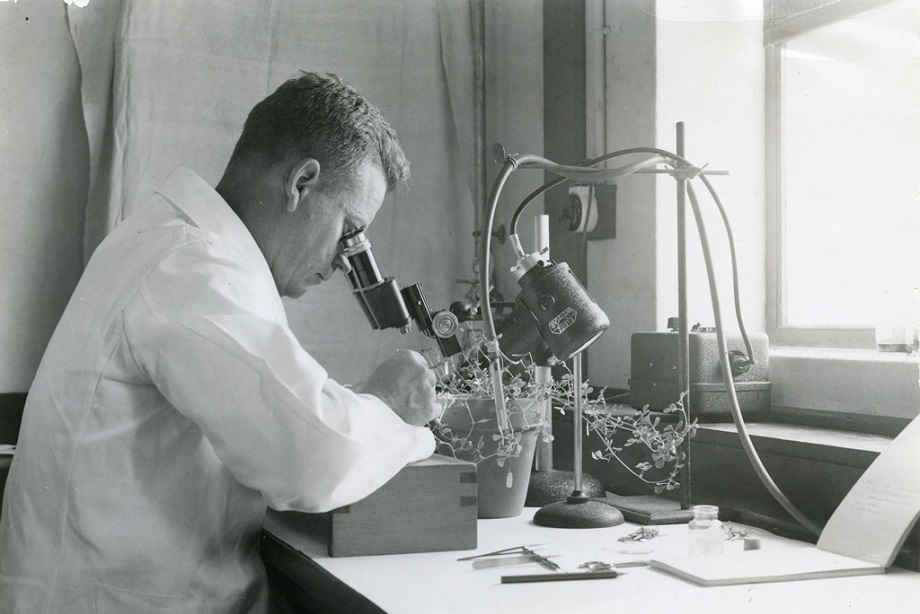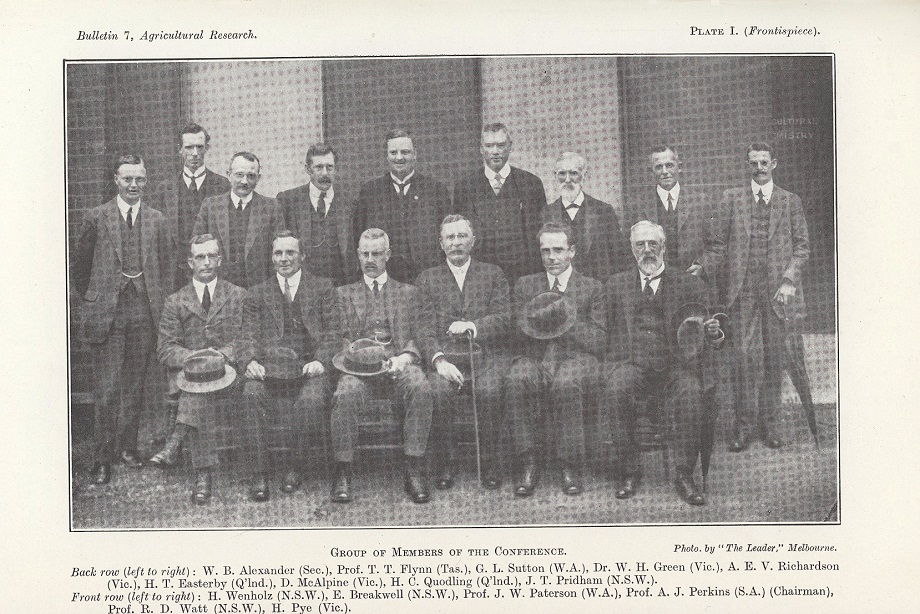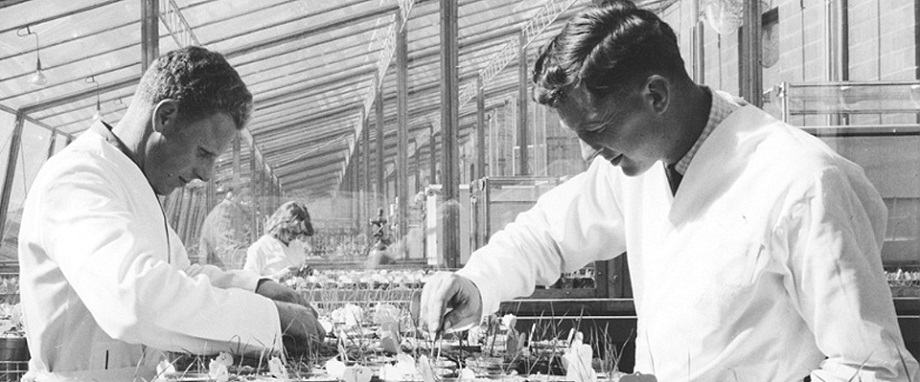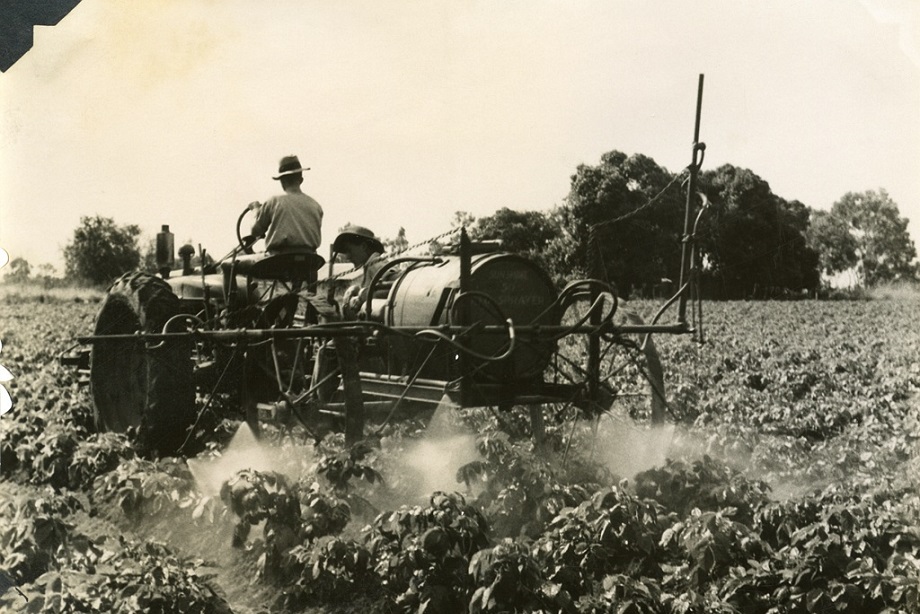
The past 100 years of Australian agricultural research have seen great advances in yields, new crops and new varieties. A meeting held 100 years ago set the agenda for many of those leaps forward.
On 9 November 2017, one hundred years will have passed since the first national meeting in Australia on agriculture research, a week-long event that marked the start of a nationwide effort towards a more productive, profitable and (more recently) sustainable agricultural sector.
Much has changed in Australian agriculture since 1917, when the stump jump plough and combine harvester were at the cutting edge, but many of the research challenges our predecessors identified still resonate a century later.
While government-funded research no longer supports the tobacco industry and power alcohols are now known as biofuels, we continue to be engaged in plant breeding and improvement, combatting cereal rusts, addressing soil fertility and seeking opportunities for value adding to raw commodities.
The wise men of our early federation (and there were no women at this meeting) recognised the critical role science-based innovation was going to play in economic development and national competitiveness. So much so that while Australia was facing national tragedy and peril with World War I at its darkest hour, our agriculture leaders managed to focus attention on how technology could build a prosperous nation in times of war and peace.

Delegates to the national meeting on Agricultural Research in Australia, Melbourne 9-16 November 1917. Published in Bulletin No. 7 of the Advisory Council of Science and Industry.
“Science can lend a most powerful aid”
The vision for a vibrant agricultural industry in our fledgling nation was articulated by Prime Minister Billy Hughes in 1916 when he announced the formation of the Advisory Council of Science and Industry; an organisation which evolved to become… you guessed it, us!
“We must create conditions which will attract and maintain a virile population of whom a sufficient number must settle upon the land and I know of no way of settling people on the land except to make rural industry attractive, and to this science can lend a most powerful aid. Science can make rural industries commercially profitable, making the desert bloom like a rose; it can make rural life pleasant as well as profitable.”
One year later it was this Advisory Council that brought together leaders in agriculture from state government departments, universities and a handful of industry leaders. They boarded steam trains and ships to gather in Melbourne.
In the halls of the University of Melbourne, and no doubt puffing away on cigars, these men discussed how fibres and power alcohol could support the war effort, and the need to advance Australia’s sugar, tobacco and fodder industries. There was already recognition of Australia’s fragile soils, with discussions around how to develop phosphate fertiliser sources in the country.

Early agriculture research was heavily influenced by the first national meeting 100 years ago, and we still feel its effects today.
A coordinated approach
A common thread throughout the meeting was the value of national coordination and collaboration. This was against a backdrop at the time of fiercely independent and competitive state interests.
The meeting did not lead to a revolution in the organisation of agricultural research and policy nationally but it did begin a tradition perhaps grudgingly at first of national dialogue and coordination which continues to this day.
One area of clear consensus was to establish a coordinated national effort to address rusts in wheat through plant breeding. This work had commenced at a national level in the 1890s and is still a focus of research for us.
There was also broad agreement to coordinate seed importation, the introduction and improvement of new cultivars, the testing of potentially useful agricultural plants and the biosecurity risks of uncontrolled plant introductions. These functions remain the domain of the Commonwealth Government.
Reflecting the significance of the USA as a source of agricultural technology of relevance to Australia (as relevant now as it was 100 years ago) it was proposed the Commonwealth send a permanent agricultural representative to America to facilitate rapid access to advances in science and technology. It is not clear however whether this occurred, but in 2017 the shoe is on the other foot. We recently set up an office in Silicon Valley with the goal of taking Australian technology to the US market.
By the late 1920s and 1930s CSIR (as we were once known) could boast some impressive successes in agriculture research, leaving no doubt as to the need for a national science agency. Among these achievements were the control of prickly pear through a partnership with Queensland and NSW State governments, the discovery and treatment of cobalt deficiency in livestock leading to coast disease, and the treatment and eradication of bovine pleuropneumonia.
Today we have an enviable reputation as a global leader in agricultural research and collaboration with state agencies and universities remains central to our operations. Our position can be traced back to that landmark meeting in 1917. Understanding a little of where we have come will surely help us navigate the challenges and opportunities of the next 100 years.

CSIRO has been on the frontline of agricultural research for its entire history, and has helped to develop farming technology and practices.
Discover more about our early history
What caused us to be established? The story goes back as far as federation.


12th November 2017 at 10:33 am
CSIRO is a great Australian brand that will need to continue to evolve to remain relevant to the Industries is serves.